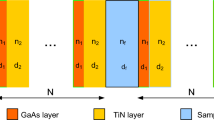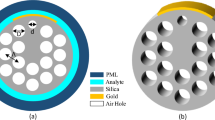Abstract
Proposed work involves the development of algorithm and computer simulation of a Hexagonal Ring Structure-based photonic sensor for the detection of harmful water impurities. An optical sensor ring structure is used to detect impurities such as Lead, DDT, Chlorine, PCB, Arsenic, Mercury, Fluoride, Aluminum. A comparison between two types of sensing structures is investigated for different water impurities. It is observed that the designed optical sensor is giving more amplitude variation for e. g 1.7 for lead impurities as compared to MZI based optical sensor with an output value of 0.4 and gives fast appropriate output. A sensitivity of 350 nm/RIU and Q factor of 3453 is obtained for the designed sensing sensor. The result has shown a feasible fabrication possibility in the future for sensing applications. Work carried having tremendous potential application in the detection of impurities in the drinking water application.












Similar content being viewed by others
References
World Health Organization. (2010). The global prevalence of hepatitis A virus infection and susceptibility: a systematic review (No. WHO/IVB/10.01).
Roy SK, Sharan P (2016) Application of machine learning for real-time evaluation of salinity (or TDS) in drinking water using photonic sensors. Drink Water Eng Sci 9:37–45. https://doi.org/10.5194/dwes-9-37-2016
D. Roy, D. R. Beltur, P. Sharan. "Detection of Marijuana in blood using GaAs substrate-based photonic sensor," 2017 International Conference on Circuits, Controls, and Communications (CCUBE), 2017
Joannopoulos JD, Meade RD, Winn JN, Russell PSJ (1996) Photonic Crystals: Molding the Flow of Light. Nature, 381(6580):290-290.
Sharma P, Sharan P (2014) Photonic crystal based ring resonator sensor for detection of glucose concentration for biomedical applications. International Journal of Emerging Technology and Advanced Engineering 4(30):702–706
Noda S (2006) Recent progresses and future prospects of two-and three-dimensional photonic crystals. J Light Technol 24(12):4554–4567
Roy SK, Sharan P (2018) Photonic Crystal Based Sensor for DNA Analysis of Cancer Detection. In Silicon Photonics & High Performance Computing (pp. 79-85). Springer, Singapore.
Robinson S, Nakkeeran R (2013) Photonic crystal ring resonator based optical filters. Advances in Photonic Crystals 1:1–26
Christoph F, Hirsch T, Wolfbeis OS (2014) Photonic crystals for chemical sensing and biosensing. Angew Chem Int Ed 53(13):3318–3335
Sharma P, Sharan P (2014) Design of photonic crystal-based biosensor for detection of glucose concentration in urine. IEEE Sens J 15(2):1035–1042
Sharma P, Sharan P, Deshmukh P (2015) A photonic crystal sensor for analysis and detection of cancer cells. In 2015 International Conference on Pervasive Computing (ICPC) (pp. 1-5). IEEE.
Roy SK, Sharan P (2020) Design of ultra-high sensitive biosensor to detect E. Coli in water. J Inf Technol 12(3):775–780
Sarkar D, Gunda NSK, Jamal I, Mitra SK (2014) Optical biosensors with an integrated Mach-Zehnder Interferometer for detection of Listeria monocytogenes. Biomed Microdevices 16(4):509–520
Vasiliev M, Alameh K (2008) Photonic nano-structures for water quality monitoring. In 19th International Conference on Optical Fibre Sensors (Vol. 7004, p. 70045E). International Society for Optics and Photonics.
Cheng D, Cao S, Ding S, Zhan S, Gao Y (2020) Ultrahigh absorption modulation in semiconductor/silver-nanoarray hybrid metasurface. Results in Physics 17:103143
Nandhini VL, Babu KS, Roy SK, Pandit K (2018) Photonic crystal based micro inter-ferometer biochip (PC-IMRR) for early stage detection of melanoma. Pertanika J Sci Technol 26(3):1505–1512
Rauf A (2013) A dielectric study on human blood and plasma. Int J Sci Environ Technol 2(6):1396–1400
Ajey SS, Bhanumathi HR, Srikanth PC, Sharan P (2020) Highly sensitive photonic crystal based biosensor for Bacillus cereus. J Inf Technol 12(4):1393–1402
Oskooi AF, Roundy D, Ibanescu M, Bermel P, Joannopoulos JD, Johnson SG (2010) MEEP: A flexible free-software package for electromagnetic simulations by the FDTD method. Comput Phys Commun 181(3):687–702
C. Jamois, R.B. Wehrspohn , “Silicon-based two-dimensional photonic crystal waveguide”, Max-Planck Institut für Mikrostrukturphysik, Weinberg 2, 06120 Halle, Germany
Liu Y, Salemink HWM (2012) Photonic crystal-based all-optical on-chip sensor. Optics express 20(18):19912–19920
Chetty G, Yamin M (2017) A distributed smart fusion framework based on hard and soft sensors. Int J Inf Technol 9(1):19–31
P. Jindal, H. J. Kaur ,“Different Configurations of Photonic Crystal Power Splitters for PIC’s” , Department of Electronics & Electrical Engineering, Chitkara University, Jhansla, Rajpura, Patiala-140401, Punjab, India
Author information
Authors and Affiliations
Corresponding author
Rights and permissions
About this article
Cite this article
Shaikh, A., Sharan, P., Srikanth, P.C. et al. A novel automated framework for water impurity detection. Int. j. inf. tecnol. 13, 785–792 (2021). https://doi.org/10.1007/s41870-020-00601-x
Received:
Accepted:
Published:
Issue Date:
DOI: https://doi.org/10.1007/s41870-020-00601-x




